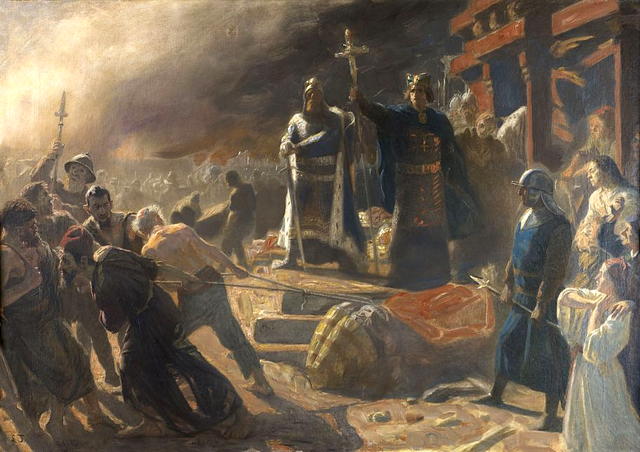MEDIEVALIST.NET

In the year 1168 a Danish bishop destroyed three pagan gods. The story is told in Gesta Danorum, by Saxo Grammaticus, which has recently been entirely translated into English for the first time
Saxo Grammaticus was a Danish cleric and historian who around the year 1188 began writing the first full history of Denmark. Stretched over 16 books, the Gesta Danorum goes back to the time before Jesus Christ to relate the mythological beginnings of the Danes. It has long been popular reading for the tales and legends it gives relating to the pagan past of this region, as well as for covering the rise of important leaders such as Cnut the Great.
As it moves into the twelfth century, the focus of the work concentrates on the rule by various Danish kings, most notably Valdemar I, who was King from 1146 to 1182. While Denmark had long been a Christian country, some of its neighbours in the Baltic Sea region were still pagan, including the Wends, a people who inhabited the island of Rügen, which lies just off the coast of northeastern Germany.
After years of pirate attacks by the Wends, King Valdemar was persuaded by Absalon, the Bishop of Roskilde and the chief royal advisor, to launch a crusade against the people. In the year 1168 the Danes landed on Rügen and besieged the capital city of Arkona. Once Valdemar’s forces set fire to the walls and buildings of the city, the residents of Arkona made a deal to surrender.
Once King Valdemar took control of Arkona and received hostages from the leaders of the Wendish people, he ordered the statue of local deity a god named Svantevit. Saxon writes that the men:
found themselves unable to wrest it
from its position without the use of axes; they therefore first tore
down the curtains which veiled the shrine, and then commanded their
servants to deal swiftly with the business of hacking down the statue;
however, they were careful to warn their men to exercise caution in
dismantling such a huge bulk, lest they should be crushed by its weight
and be thought to have suffered punishment from the malevolent deity.
Meanwhile a massive throng of townsfolk ringed the temple, hoping that
Svantevit would pursue the instigators of these outrages with his
strong, supernatural retribution.
After much work, the men cut down the statue:
With a gigantic crash the idol
tumbled to earth. The swarths of purple drapery which hung about the
sanctuary certainly glittered, but were so rotten with decay that they
could not survive touching. The sanctum also contained the prodigious
horns of wild animals, astonishing no less in themselves than in their
ornamentation. A devil was seen departing from the inmost shrine in the
guise of a black animal, until it disappeared abruptly from the gaze of
bystanders.
While the god in Arkona was being destroyed, the Danes received word from the people of Karenz – another important town on the island – they were ready to surrender. Absalon traveled to the town along with 30 men, where they were met by 6000 warriors. However, the Wends prostrated themselves to the Christians and welcome the bishop.
Karenz was the home to three pagan deities - Rugevit, Porevit and Porenut – which were believed to be the gods of war, lightning and thunder. Bishop Absalon came to destroy these gods, and Saxo Grammaticus (who may have been an eyewitness) describes the scene of coming across the the first of the three pagan temples:
The largest shrine was surrounded by
its own forecourt, but both spaces were enclosed with purple hangings
instead of walls, while the roof gable rested only on pillars. Therefore
out attendants tore down the curtains adorning the entrance area and
eventually laid hands on the inner veils of the sanctuary. Once these
had been removed, an idol made of oak, which they called Rugevit, lay
open to the gaze from every quarter, wholly grotesque in its ugliness.
For swallows, having built their nests beneath the features of its face,
had piled the dirt of their droppings all over its chest. A fine
deity, indeed, when its image was fouled so revoltingly by birds!
Furthermore, in its head were set seven human faces, all contained under
the surface of a single scalp. The sculptor had also provided the same
number of real swords in scabbards, which hung on a belt at its side,
while an eighth was held brandished in its right hand. The weapon had
been inserted into its fists, to which an iron nail had clamped it with
so firm a grip that it could not be wrenched away without severing the
hand; this was the very pretext needed for lopping it off. In thickness
the idol exceeded the width of a human frame, and its height was such
that Absalon, standing on the toes of its feet, could hardly reach its
chin with the small battleaxe he used to carry.
The men of Karenz had believed this
to be the god of war, as though it were endowed with the strength of
Mars. Nothing about the effigy was pleasant to look at, for its
lineaments were misshapen and repulsive because of the crude carving.
Every citizen was possessed by sheer
panic when our henchmen began to apply their hatchets to its lower legs.
As soon as these had been cut through, the trunk fell, hitting the
ground with a loud crash. Once the townsfolk beheld this sight, they
scoffed at their god’s power and contemptuously forsook the object of
their veneration.
Not satisfied with its demolition,
Absalon’s workforce now stretched their hands all the more eagerly
towards the image of Porevit, worshipped in the temple close by. On it
were implanted five heads, though it had been fashioned without weapons.
After that effigy had been brought down, they assailed the sacred
precinct of Porenut. Its statue displayed four faces and a fifth was
inserted in its breast, with its left hand touching the forehead, its
right the chin. Here again the attendants did good service, chopping at
the figure with their axes until it toppled.
After the idols had been broken, the Danish bishop wanted to inflict a more permanent destruction on the pagan gods:
Absalon then issued a proclamation
that the citizens must burn these idols the city, but they immediately
opposed his command with entreaties, begging him to take pity on their
overcrowded city and not expose them to fire after he had spared their
throats. If the flames crept to the surrounding area and caught hold of
one of the huts, the dense concentration of buildings would undoubtedly
cause the whole mass to go up in smoke. For this reason they were bidden
to drag the statues out of town, but for a long time the people
resisted, continuing to plead religion as their excuse for defying the
edict; they feared that the supernatural forces would exact vengeance
and cause them to lose the use of those limbs they had employed to carry
out the order. In the end Absalon taught them by his admonitions to
make light of a god who had not power enough to rise to his own defence,
once they had become confident of being immune from punishment, the
citizens were quick to obey his directions.
So that he might show them the idols
deserved disdain, Sven made it his business to stand high on top of them
while the men of Karenz were heaving them away. In so doing he added
affront by increasing the weight and harassed the pullers as much with
humiliation as with the extra burden, when they viewed their deities in
residence lying beneath the feet of a foreign bishop.
As this was being done, Bishop Absalon went about preparing the area
to be Christian. He first consecrated three burial sites in the
countryside just outside Karenz, and after celebrating a mass baptized
the people. Saxo then adds, “Likewise by constructing churches in a
large number of localities, they exchanged the dens of an esoteric
superstition for the edifices of public religion.”Gesta Danorum: The History of the Danes, has been edited and translated by Karsten Friis-Jensen and Peter Fisher and was published in two volumes earlier this year by Oxford University Press.




0 Comentarios